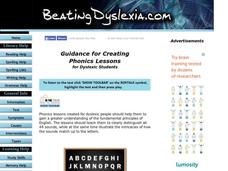Curated OER
Guidance for Creating Phonics Lessons for Dyslexic Students
Here is a quick and easy guide to help a new teacher build phonics lessons for students with dyslexia. It stresses the importance of fundamental basics while also providing clear and direct instructional practices that will help you...
Curated OER
Phonics Help: The Phonic Alphabetic Code Chart
Phonics is a fundamental key to reading success. To help your learners with dyslexia or learning disabilities, try using the phonic alphabetic code chart. The chart and full instructions on how it can be used in the classroom are...
Curated OER
Get Rid of It!
Young scholars participate in matching game to practice their phonics awareness. They can apply the activity to any curriculum review that is word or vocabulary based.
Meadows Center for Preventing Educational Risk, University of Texas at Austin
Lesson 2 - Consonant-Vowel-Consonant Words
Closed syllable words contain short vowel sounds. A phonics lessons introduces readers to consonant-vowel-consonant words. Guided instruction introduces the words with a series of dictation activities, and then learners practice reading...
Curated OER
Fraction Spelling
An interesting take on spelling practice is included here! Emerging spellers take their weekly spelling list and create a three-column chart. In the first column, they write the word itself. In the second column, they write how many...
Curated OER
Move the Sounds
Use cut out letters to make beginning sounds, blends, and word families that ultimately make new words. Learners move around physically as they hold the letters to make the specified blend or word. Assessment suggestions are included.
Curated OER
Sing Your Way Through Phonics
Students recognize and spell sets of words with/shun/suffixes. They become familiar with common t-i-o-n, s-i-o-n, s-s-i-o-n, and c-i-a-n words. Students listen as the teacher say, "I'm going to say several different words that all have...
Curated OER
Applying Decoding, Vocabulary, and During Reading Strategies
Apply reading strategies to boost phonemic awareness. While reading a provided informational text, learners use decoding, vocabulary, and a graphic organizer to strengthen their overall reading ability. Handouts and the reading passage...
Curated OER
Guess Which Word?
Students listen to clues to a mystery word. They use phonics and language skills to figure out a mystery word.
Curated OER
Lesson Plan: Final Phoneme ll, ff, ss
Young scholars apply word level skills through shared and guided reading.
Curated OER
Lesson Plan: Initial "s" clusters
Young scholars identify words in Sleeping Beauty which begin with the letter 'S'.
Curated OER
The Fly Swatter Game
Students are placed in small groups to participate in the "Fly Swatter Game" to reinforce phonetic sounds of letters.
Curated OER
Word Family Nuts
Students explore the English language by participating in a word match activity. In this word family lesson, students write a specific word family on a paper squirrel and write words that belong to the family on a paper acorn. Students...
Curated OER
Lights, Camera, and Action!
These activities center around acting out a play to help create fluent readers who use expression and emotion. As readers work through the play the first time, they also practice decoding strategies. In small groups of four, they then...
Curated OER
Word Origins
Understanding a word's etymology can really help with decoding and building vocabulary skills. Readers compare and contrast words of similar origins but with different difficulty levels. They focus on prefixes, suffixes, and affixes....
Curated OER
Vocabulary through Text
Explore word meanings. Sixth graders identify examples of words with affixes while listening to the story Paul Bunyan by Steven Kellogg. They participate in the game "Pass the Parts" and practice separating given words into their root...
Curated OER
Reading Comprehension: My Lucky Day
Tell a story using pictorial representations as textual support. Special education pupils reading at an elementary level will enjoy identifying characters and other story elements while increasing their vocabulary with their handy PECS...
American English
Welcome to the Color Vowel Chart
Focus English language learners' attention on word stress and phrase stress with a pronunciation chart that breaks the sounds into moving and non-moving vowel sounds. The chart tool uses colors and key words to indicate where to put the...
Meadows Center for Preventing Educational Risk, University of Texas at Austin
Lesson 17 - Adding Suffixes That Change Base Words' Finally to I
If it ends in a y, change the y to i when adding a suffix like -ness, -ly, or fy. The final lesson in the Word Recognition and Fluency series of 17 explains when to change the final letter in a base word to i before adding a suffix....
Meadows Center for Preventing Educational Risk, University of Texas at Austin
Lesson 15 - Soft G and Soft C
The names Cindy and Carrie start with the same letter, but have very different sounds. The 15th of 17 word recognition lessons focuses on the soft C sound found in Cindy and the soft G sound found in Gene. Direct instruction starts with...
Meadows Center for Preventing Educational Risk, University of Texas at Austin
Lesson 13 - Multisyllabic Word Reading
One- and two-syllable words may flow from the tongue with ease, but longer words, such as department and volcano, feel like tongue twisters. Scaffolded instruction explains how to break words into their individual syllables, and then...
Meadows Center for Preventing Educational Risk, University of Texas at Austin
Lesson 10 - Compound Words
Individually, words have power, but when added together, they can take on a whole other level of meaning. Readers learn about compound words in the 10th of 17 lessons of the Word Recognition and Fluency series. A script provides guidance...
Meadows Center for Preventing Educational Risk, University of Texas at Austin
Lesson 9 - Contractions
Is it do'nt or don't? How about doesn't or does'nt? A lesson on contractions helps learners identify, form, and use contractions. Components within the plan include direct instruction on decoding and encoding contractions, as well as...
Meadows Center for Preventing Educational Risk, University of Texas at Austin
Lesson 3 - Consonant Digraphs
Words such as witch, whack, and wish often cause beginning readers to struggle. The third installments in the Word Recognition and Fluency series of 17, covers consonant digraphs. Activities guide learners through the identification and...
Other popular searches
- Teaching Phonics
- Phonics Worksheets
- Phonics Blends
- Phonics Lesson Plans Vowels
- Phonics Lesson Plans
- Phonics Rules
- Phonics Games
- Phonics Worksheets Oi Oy
- Phonics Lessons
- Phonics Activities
- Phonics /Ch/
- Phonics Games Short Vowels

























